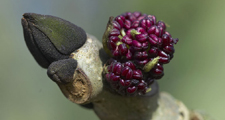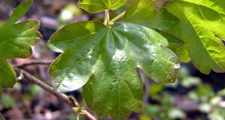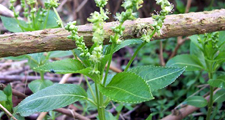Lowland Ash Woodland – NVC W8
Fraxinus excelsior – Acer campestre – Mercurialis perennis woodland.
Distribution
Typical of the East Durham Limestone Plateau and localised sites in the Tees Lowlands. Transitional in the North Pennines and Dales Fringe with W9.
Character
Dene & escarpment woodlands on the limestones of the East Durham Plateau. Secondary woodlands of abandoned limestone quarries. Gorge and ravine woodlands in the Dales Fringe.
Geology
Magnesian Limestone. Carboniferous Limestone.
Soils
Shallow soils over limestone, Brown Calcareous Earths.
Species
Ash and Wych Elm are the dominant species with Sycamore often replacing Elm where it is diseased. Common Oak is locally common. Hazel is often dominant in the understorey with a range of other shrubs including Hawthorn, Blackthorn, Elder, Guelder Rose, Privet, Goat & Grey Willow. Field Maple is occasionally present in the south & east. Yew is locally abundant on shallow soils. Dogwood is found locally as are Small-leaved Lime, Spindle and Spurge Laurel.
Ground Flora and Fauna
Dog’s Mercury, Sweet Woodruff, Sanicle, Ramsons, Wood Anemone, Cuckoo Pint. Alkaline Ash bark supports rich lichen flora. Invertebrate fauna particularly important.
Structure
Semi-natural woodlands have a high degree of species and structural diversity. Ash and Elm are dominant in the canopy although most woodlands have been heavily affected by Elm disease. The understorey is usually well developed and diverse.
Management Principles
- Prevent grazing by livestock or browsing by deer – particularly in small woods.
- Progressively remove non-native species.
- Maintain and increase the numbers of old trees and dead wood.
- Low intervention approaches are usually best & particularly for small woods.
- Use low impact felling & extraction techniques – minimise the scale of disturbance at any one time.
- Maintain areas of open ground.
- Use low-key establishment techniques – particularly natural regeneration.
- When planting is necessary use native species of local origins.
- Planting sites for new woods Escarpment and coastal Dene sites on calcareous soils. Limestone quarries. On grassland sites specialist advice should be taken on the value of existing vegetation. On upland and upland fringe sites W9 may be a more appropriate model.
- Design principles Simple planting mixtures based on Ash, Hazel and Hawthorn together with smaller numbers of minor species such as Oak and Blackthorn. Others species can be introduced in small numbers or left to colonise naturally. Rare species such as Small-leaved Lime and Spindle should generally be avoided. Field Maple should be used sparingly in the north. The provision of some open space and lower density planting may foster the development of a herb rich ground flora.
Further Information
- Forestry Commission Forestry Practice Guide 3: Lowland Mixed Broadleaved Woods can be downloaded from Forestry Commissions Publications pages.



